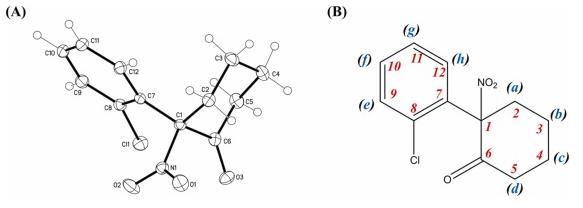2-(2-chlorophenyl)-2-nitrocyclohexanone: Identification and Application
Dec 22,2022
General description
2-(2-chlorophenyl)-2-nitrocyclohexanone is a precursor to the synthesis of Norketamine. Noxamine has similar pharmacological effects to ketamine, which is not a controlled drug in many countries.
Identification
The identification of new psychoactive substances (NPSs) and their precursors is crucial to understand trends in NPSs so that they can be regulated before they pose a serious threat to human health. In this case, 24 bags containing approximately 600 kg of yellow powder were seized; the smugglers had been monitored for 3 years by the officers of Taiwan's Ministry of Justice Investigation Bureau. A handheld Raman analyzer yielded a positive result for N-boc norketamine; thus, the seized powder was sent to this laboratory for confirmation through gas chromatography-mass spectrometry, liquid chromatography-high-resolution mass spectrometry, proton nuclear magnetic resonance (H-1 NMR), carbon-13 nuclear magnetic resonance (C-13 NMR), two-dimensional correlation NMR measurements (2D_COSY), heteronuclear single-quantum correlation NMR measurements (2D_HSQC), and single-crystal X-ray diffraction. This thermolabile powder was subsequently identified as 2-(2-chlorophenyl)-2-nitrocyclohexanone (2-CPNCH), which can be employed as a precursor for the synthesis of norketamine and is available commercially. Norketamine has similar pharmacological effects to ketamine and phencyclidine but is not regulated in many countries. In this case report, mass fragments, H-1 NMR, C-13 NMR, 2D_COSY, and 2D_HSQC data of 2-CPNCH are presented; moreover, how criminals exploit the loopholes in the law for conducting unauthorized drug manufacturing is discussed [1].

Fig. 1. (A) Chemical structure of the seized powder (2-CPNCH) and (B) its representative labels for carbon (C1–C12) and hydrogen (Ha–Hh) atoms.
Application
High Yielding Continuous-Flow Synthesis of Norketamine
2-(2-chlorophenyl)-2-nitrocyclohexanone is a precursor to the synthesis of Norketamine. This is where 2-(2-chlorophenyl)-2-nitrocyclohexanone is involved in synthesis. A new continuous-flow process is presented for synthesis of the pharmaceutical intermediate norketamine (5). Our approach has been to take the well-established and industrially applied batch synthetic route to this promising antidepressant precursor and convert it to a telescoped multi-stage continuous-flow platform. This involves the α-bromination of a ketone, an imination/rearrangement sequence with liq. ammonia, and a thermally induced α-iminol rearrangement. Our approach is high yielding and provides several processing advantages including the redn. of many of the hazards conventionally assocd. with this route, particularly in the handling of liq. bromine, hydrogen bromide gas, and liq. ammonia. Each of these presents serious operational challenges in a batch process at scale [2].
Method for preparation of Ketamine intermediate 2-(2-chlorophenyl)cyclohexanol and application in synthesis of Ketamine
Ketamine, known chemically as 2-o-chlorophenyl-2-methylamine cyclohexanone, is a derivative of amphetamine-type compounds. Ketamine is an intravenous general anesthetic. It is used as a surgical anesthetic or anaesthesia inducer in clinic and has certain mental dependence. And has the effect of bronchodilation, so it is suitable for the treatment of asthma patients. At the same time, it can be used as a dilator for cerebrovascular. The existing synthesis of ketamine usually starts with the preparation of 1-hydroxycyclopentyl o-chlorophenone, but through the rearrangement reaction of 1-hydroxycyclopentyl o-chlorophenone n-methylamine hydrochloride, ketamine hydrochloride is obtained. The present invention discloses an intermediate compound for synthesizing ketamine by including the following steps: (i) o-chlorobenzene reacts with alkyl lithium to obtain o-chlorobenzene lithium; (i i) is obtained by the reaction of o-chlorophenyl lithium with oxidized cyclohexene under the action of Lewis acid. The intermediate compound can be oxidized and nitrified to obtain 2-(2-chlorophenyl)-2-nitrocyclohexanone, nitro reduction, amine methylation to produce ketamine. Compared with the existing ketamine synthesis method, the invention has the advantages of simple route, low cost and convenient operation. 2-(2-chlorophenyl)-2-nitrocyclohexanone is the synthetic intermediate here [3].
Preparation of (phenyl)octahydrobenzo[b][1,4]oxazines/oxazipines as NMDA receptor antagonist
NMDA-type glutamate receptor (NMDAR) is a ligand-gated ion channel. This receptor can be activated in vivo by glutamate, the most important excitatory neurotransmitter in the central nervous system, thus mediating the transmission of excitatory signals between synapses. After the opening of ion channels, the permeability of NMDAR to Ca2+, K+, Na+ and other cations is enhanced, generating excitatory postsynaptic potential and triggering a series of physiological and biochemical reactions. In the usual resting state, NMDAR is blocked by Mg2+ in a voltage dependent manner. Depolarization of nerve cell membrane can release the blocking effect of Mg2+ on NMDAR ion channels, and then after binding with corresponding ligands, NMDAR can be activated, and the activation of NMDAR is regulated by membrane potential and ligands. This is where 2-(2-chlorophenyl)-2-nitrocyclohexanone is involved in synthesis [4].
References
[1] Yen Y T, Tseng S H, Huang D Y, et al. Identification of a novel norketamine precursor from seized powders: 2-(2-chlorophenyl)-2-nitrocyclohexanone[J]. Forensic Science International, 2022, 333: 111241.
[2] Hernando M V, Moore J C, Howie R A, et al. High Yielding Continuous-Flow Synthesis of Norketamine[J]. Organic process research & development, 2022, 26(4): 1145-1151.
[3] Zhang F, Peng R, Zhang Z. Method for preparation of Ketamine intermediate 2-(2-chlorophenyl)cyclohexanol and application in synthesis of Ketamine[P]. Faming Zhuanli Shenqing, 2017, 106478367.
[4] Zhu J, Chen Y, Geng Y, et al. Preparation of (phenyl)octahydrobenzo[b][1,4]oxazines/oxazipines as NMDA receptor antagoni[P]. Faming Zhuanli Shenqing, 2021, 113234036.
- Related articles
- Related Qustion
- 2-(2-Chlorophenyl)-2-nitrocyclohexanone: Overview, Side Effects and Dosage Feb 21, 2024
Follow medical guidance for safe application of 2-(2-Chlorophenyl)-2-nitrocyclohexanone cream to treat fungal skin infections and minimize side effects.
2,3,5,6-tetrafluoroterephthaldehyde is the intermediate of synthetic materials.....
Dec 22,2022Organic Synthesis IntermediateZinc sulfide is an inorganic compound, the chemical formula is ZnS, the appearance is white or slightly yellow powder, and the color will become darker when exposed to light. It is stable in dry air, and it will gradually oxidize to zinc su....
Dec 22,2022Inorganic salts2-(2-Chlorophenyl)-2-nitrocyclohexanone
2079878-75-2You may like
2-(2-Chlorophenyl)-2-nitrocyclohexanone manufacturers
- 2-(2-Chlorophenyl)-2-nitrocyclohexanone
-

- $2.00 / 1kg
- 2024-07-25
- CAS:2079878-75-2
- Min. Order: 1kg
- Purity: 99%
- Supply Ability: 300tons
- 2-(2-Chlorophenyl)-2-nitrocyclohexanone
-

- $1.00 / 1kg
- 2024-07-25
- CAS:2079878-75-2
- Min. Order: 1kg
- Purity: 99%
- Supply Ability: 10 TONS
- 2-(2-Chlorophenyl)-2-nitrocyclohexanone
-

- $0.00 / 1kg
- 2024-07-06
- CAS:2079878-75-2
- Min. Order: 1kg
- Purity: 0.99
- Supply Ability: 10T





